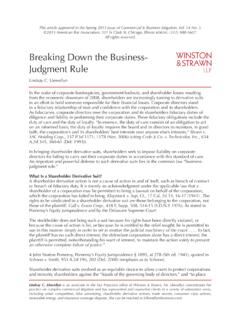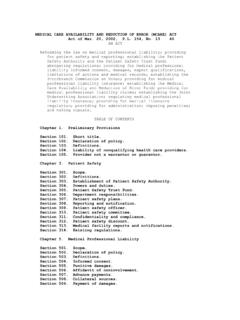Transcription of Negotiating Limitation of Liability Provisions in Agency ...
1 Negotiating Limitation of Liability Provisions in Agency -Client AgreementsPresenters: Brian HeidelbergerMonique (Nikki) BhargavaToday s Presenters2 Brian HeidelbergerChair, Advertising, Marketing & Brand Enforcement Protection PracticeChicago+1 Monique (Nikki) BhargavaAssociate, Advertising, Marketing & Brand Enforcement Protection PracticeChicago+1 The IssueClient ViewVendor/ Agency is caretaker of services, IP, and dataIf the Vendor/ Agency is at fault, why limit its liabilityAgency is in part being hired to take on the riskVendor/ Agency is an attractive target for hackers because it works with multiple clients Agency ViewSometimes risk is unavoidable Often Vendor/ Agency is a victim tooJust because client is paying, does not mean it should be allowed to outsource 100% the risk$XX.
2 000 revenue stream is not worth $XXMM riskClient is an attractive target due to deep pocketsClient Wants Agency /Vendor to Be LiableVendor/ Agency Wants to Limit Its Liability Two Diametrically Opposing Points of View4 Two Diametrically Opposing Points of ViewClient View Clients may treat all risks in a similar fashionVendor/ Agency should be responsible for all its own third-party vendorsAgencies need to be thoughtful on what they pitch and be accountableAgencies can t suggest ideas and make the client liable for researchingAgency ViewVendor/ Agency wants to avoid taking on more Liability than dictated by the type of services it is providingVendor/ Agency is often working with third-party vendors that will limit their own liabilityThe type of services being conducted sometimes depends on the ability to take on risks which is a cost of doing business for clientClient Wants Agency /Vendor to Be LiableAgency/Vendor Wants to Limit Its Liability 5 Scope of IndemnificationWhat is the Proper Allocation of Risk?
3 Client Wants to be Indemnified for: Violation of laws Security Breach incidents Failure to comply with obligations Third-party services/data/tools Patents Materials and claims supplied by AgencyAgency Wants to Limit Indemnification to: Intentional acts, gross negligence, or wilful misconduct Material failure to maintain the described security protocols Pass-through indemnification to the extent received Limited patent responsibilityClient Wants to Limit Indemnification to: Intentional acts, gross negligence, or wilful misconduct Client IP Product liabilityAgency Wants to be Indemnified for.
4 Violation of laws Improper provision of data Failure to comply with obligations Third-party services/data/tools Risks client has opted to take Client supplied Information Product Liability Client modifications/scope of use7 Limitation of Liability ProvisionsTypical Limitation of Liability Provisions limitations based on type of damage Direct Consequential Lost Profits/Revenue punitive limitations based on cause of damage Breach of Confidentiality Data/Privacy Indemnification Patent and Other IP claims limitations on amounts of damages9 Typical Limitation of Liability Provisions Requested Disclaimer of Liability for Certain Damages Consequential, special, incidental, indirect damages, punitive damages, or lost profits/reputational harm; and Cap on Total Liability Often capped to total fees paid under the contract, or fees paid in the prior 12 monthsSource: 2016 Willis Towers Watson Winter 2016 Cyber Claims Brief10 Typical Provision Limitation of Liability .
5 IN NO EVENT SHALL EITHER PARTY BE LIABLE FOR ANY INDIRECT, INCIDENTAL, SPECIAL OR CONSEQUENTIAL DAMAGES, OR DAMAGES FOR LOSS OF PROFITS/REPUTATIONAL HARM, REVENUE, DATA, OR USE, INCURRED BY OTHER PARTY OR ANY THIRD PARTY, WHETHER IN AN ACTION IN CONTRACT OR TORT, EVEN IF SUCH PARTY HAS BEEN ADVISED OF THE POSSIBILITY OF SUCH Liability OF FOR A SERVICE IS LIMITEDIN ALL CASES AND IN THE AGGREGATE TO THE AMOUNT OF FEES ACTUALLY PAIDBY COMPANY FOR THE CORRESPONDING SERVICE DURING THE TWELVE (12)MONTHS PRECEDING THE DATE OF THE EVENT THAT IS THE BASIS FOR THE FIRST Carve-Out to Provision Limitation of Liability .
6 EXCEPT WITH RESPECT TO CLAIMS OF INDEMNITY, BREACH OF CONFIDENTIALITY, BREACH OF DATA SECURITY OBLIGATIONS, AND ARISING FROM A DATA INCIDENT (AS SET FORTH IN SECTION XX), IN NO EVENT SHALL EITHER PARTY BE LIABLE FOR ANY INDIRECT, INCIDENTAL, SPECIAL OR CONSEQUENTIAL DAMAGES, OR DAMAGES FOR LOSS OF PROFITS/REPUTATIONAL HARM, REVENUE, DATA, OR USE, INCURRED BY OTHER PARTY OR ANY THIRD PARTY, WHETHER IN AN ACTION IN CONTRACT OR TORT, EVEN IF SUCH PARTY HAS BEEN ADVISED OF THE POSSIBILITY OF SUCH WITH RESPECT TO CLAIMS OF INDEMNITY, BREACH OF CONFIDENTIALITY, BREACH OF DATA SECURITY OBLIGATIONS, AND ARISING FROM A DATA INCIDENT (AS SET FORTH IN SECTION XX)
7 , TOTAL Liability FOR A SERVICE IS LIMITED IN ALL CASES AND IN THE AGGREGATE TO THE AMOUNT OF FEES ACTUALLY PAID BY COMPANY FOR THE CORRESPONDING SERVICE DURING THE TWELVE (12)MONTHS PRECEDING THE DATE OF THE EVENT THAT IS THE BASIS FOR THE FIRST Two Questions Consequential: Parties often agree to this with carve-outs, but .. do they know exactly what they are giving up? Indemnity: Parties often agree to this carve-out, if necessary, assuming it will be covered by insurance, but .. patent infringement is often not covered by insurance Confidentiality: Parties often agree to this carve-out, if necessary, assuming that the chance of a significant loss will be low but.
8 This should be confused with a carve-out for data breach/privacy claims Data Breach: Agencies/Vendors highly contest this Liability given the perceived large potential liability1) Will the Agency be liable for consequential damages and/or lost profits/reputational harm for claims of indemnity, confidentiality and data breach, and if so, how much? Parties sometimes agree to a cap on direct damages (1x, 2x, or 3x amount paid), but clients press to have unlimited Liability claims of indemnity, confidentiality, and data breach 2) Will there be an overall cap on Liability , and if so, will claims of indemnity, confidentiality, and data breach be excluded?
9 13 Exclusion of DamagesWhat Are the Types of Damages? Direct Damages which, in the ordinary course of human experience, can be expected to naturally and necessarily result from a breach These damages are presumed to have been foreseen or contemplated by the parties as consequences of a breach Consequential or Special Damages Damages that arise out of special circumstances, not ordinarily predictable May not be obvious to one of the parties in advance without communication of the other party s special circumstances Incidental Expenses or commissions in connection with effecting cover and any other reasonable expense incident to the delay or breach15 How Are Damages Categorized?
10 Often Seen as Direct Money paid for the service Cost of corrections of Work Product Lost profitsOften Seen as Indirect, Consequential, or Incidental Lost value of consumer information Lost profits from business interruption Loss of revenue from downstream relationships Data breach notification and remediation-related costs Attorneys fees and other expenses Third-party claims (in some cases) Government fines or penalties damage to reputation Increased customer attrition/reputation damage16 Common Exclusions Exclude consequential, incidental, indirect, damages Exclude lost profits/revenue and/or reputational harm Do not assume that these are consequential damages Carve-outs to Exclusions Indemnification with caution about patent Liability Confidentiality Data Breach/Privacy Consider Liability in the context of your insurance limits17 Unenforceable Exclusions All damages, particularly in sales contracts Whitesell Corp.






